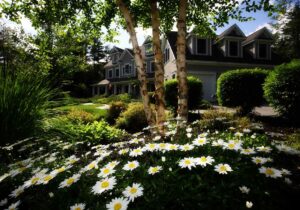
Want to keep them around for generations?
Find out how we can keep your trees in top shape all year every year, guaranteed. And, you will never have to call a tree care company again.
If interested, we can schedule a visit and tell you how our Tree Care for Life program would work for your property.

Tree Preservation Plans are often required when building a new home, and their requirements vary among different municipalities.
Our number one goal in this process is to save you time and money in permitting and construction. Because each construction site is unique, each requires a unique approach to tree preservation and permitting considerations.
Nova Arborist has completed hundreds of approved Tree Preservation Plans in many different municipalities.
Our Tree Preservation Plans include key elements such as:
Existing trees and forested areas surveyed on site and plotted precisely on drawings
Tree Inventory showing species, size, condition, description & recommendations
MInimizing where possible new tree planting requirements
Critical Root Zone delineation
Limits of grading/ground disturbance
New development on the site (i.e. buildings, paving, changes to existing grades)
Tree protection fencing and other protection measures
Tree protection signs
Root pruning areas
Selecting ideal new tree species' to be planted after construction (IF required)
Detailed planting schedule showing species, number, size, canopy coverage credit
Canopy coverage calculations as required
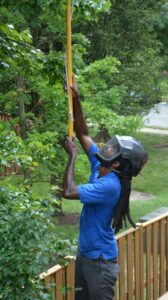
Because drastic cuts or changes in shapes of trees cannot be reversed, our approach is to work conservatively and thoughtfully toward the pruning goal until it is reached.
Pruning trees should be a decision-making process from start to finish. Knowing what to prune, when to prune, where to prune, how to prune, and how much to prune are all important for the future health and maintenance needs of the tree. Each limb must be inspected and each cut should be chosen carefully.
What is Fine Pruning?
Fine Pruning involves 3 basic principles.
Decision-making. This is a crucial aspect of pruning trees from start to finish. First, each job we do is headed up by a Certified Arborist, who carefully studies each individual tree and its surroundings. We examine the tree for health and/or structural issues, and collaborate with you on your pruning goals. Then, we develop a pruning plan for the tree. As we begin the work, and especially with larger trees, we carefully consider each and every cut we make.
The cut. It is most important for the healing and recovery of the tree that pruning cuts be made properly. This is determined by both the technique and the tools used for the job. We use a variety of hand saws, pole saws, pole pruners, pruning shears, and chain saws. It is important that the tools are sharp and the resulting cut is clean, smooth and even across. In each neighborhood we visit, we see examples of both fine pruning and damaging, unsightly and often irreversible mistakes. The company you hire should have a reputation for quality and conscientious work.
Care of surroundings. It would be pointless to prune or remove a tree and in the process damage adjacent trees or property, yet it is surprisingly common. We take great care in our pruning and removal operations to avoid damaging other trees, structures and landscape.
Tree Maintenance
Trees are just like us and every other living being – they stay healthier and look better with periodic maintenance.
Periodic maintenance helps your trees…
Always look their best,
Defend against pests and diseases, and
Stay upright and structurally intact.
Maintenance is the key to keeping your trees looking their best and costing you less! For most trees, some light pruning, done correctly, every 3-5 years is enough to keep them strong, healthy and beautiful.
It is important to note that a sick or problematic tree need NOT always be cut down! We rehab neglected and dilapidated trees all the time, restoring their health, beauty and structural integrity.
Considering that a large, mature tree can cost thousands of dollars to remove and a lifetime to replace, periodic maintenance is the best approach.
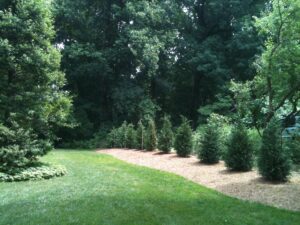
Most companies offer a 1-year guarantee on the trees they plant. We guarantee the health & beauty of our trees for life, barring any physical damage, because we start with the best specimens and plant them correctly.
Planting a tree that will grow and stay healthy isn’t nearly as simple as putting it in the ground and watering. From selecting the best specimen at the nursery to digging the hole properly to the watering plan, there are important details in the planting process that a homeowner or landscaper may overlook. If this happens, the tree may struggle along for several years looking sickly, not gaining size, before it finally gives up and you start the process over again. This wastes your time and your money.
Our tree planting process includes tree sourcing, hand-selection, delivery, planting, soil amendments, mulch, watering bag & initial health & maintenance pruning.
Trees live for generations, so it is important to choose the right trees for your landscape and give them the best start.
Species Selection
Here are some of the factors we consider in helping you select the right species:
Purpose – Ornamental, screening, shading, wildlife attraction, or framing a landscape, house or building.
Aesthetic Preferences – Shape, mature size, evergreen or deciduous, single or multiple trunks, blooms or leaf color, bark texture, fall color.
Available Space – Understand the growth rate, mature size and shape of the tree you are planting. Most any tree can be pruned regularly to stay within a certain space. However, if you want to let the tree grow naturally to its mature size and shape, ensure it will not interfere with overhead lines, walkways, buildings and windows, etc. The roots also have to be considered. Large-growing trees should not be planted closer than 15 feet from a home’s foundation. In addition to cracking foundations, roots can eventually lift driveways, walkways and steps.
Sunlight & Shade – Determine the number of hours of direct sun the planting site receives in summer, since different tree species require differing amounts of sunlight.
Soil & Ground Conditions – Factors to consider here are the type of soil (sandy or clay or in between), and drainage properties of the area.

The most common reasons for tree removal are that either the tree is dead or that it has structural and/or health issues that make it hazardous or unsightly to leave in place.
We would rather save your tree than remove it if it can be made healthy and safe. This is usually the cheaper way to go! If it must be removed, it should be done in a manner that preserves the surrounding structures, trees and their root zones.
When should a live tree be removed?
When deciding whether to remove a tree, we look at several different risk factors. Generally, if a tree has two or more of the following risk factors, or one that is extreme, we recommend removing the tree.
Risk Factors:
1. Weight Distribution – Most of the time, a tree will collapse in the direction it is weighted.
If a tree is leaning significantly or has all of its growth on one side, this puts uneven stress on the root system, and the tree stands a chance of uprooting.
If there are valuable “targets” in the direction of the weight such as a house, power lines or trafficked area, this may be reason enough to remove the tree.
2. Trunk Damage – Regardless of whether a tree’s canopy appears healthy, trunk damage can render a tree structurally unstable.
If you can see a cavity or outward signs of decay any place on the trunk (especially at the base), then the tree’s stability may be in a steady decline. Once the decay process has started, it is irreversible.
3. Ground Conditions – There are several ground conditions that decrease the stability of a tree, regardless of its health.
The first is the slope of the ground – a steep slope provides a less stable foundation for a tree than flat ground.
Another risky position for a tree is right along the bank of a creek or river bed. In this case, the dirt underneath the tree is being constantly eroded away and the tree will eventually collapse.
A third hazardous location is one where water collects and keeps the ground wet. Less firm soil means less “grip” for the roots. This is why many trees uproot in heavy rainstorms – the combination of a soggy ground and high winds is enough to bring down even the most healthy, well-established tree.
4. Multiple Dead Limbs – When a tree has several large dead limbs (roughly 25% or more of the total canopy), this is a sign of a serious circulatory problem.
If you look closer, you will probably notice trunk decay or a disturbance of the root system. The tree is likely in a decline toward death.
If the dead branches are over a structure or play area, either the branches or the tree should be removed.
If the tree is dead or dying, it’s wise to remove it sooner rather than later. The longer a large tree has been dead, the more hazardous it becomes and the more dangerous it becomes for removal.
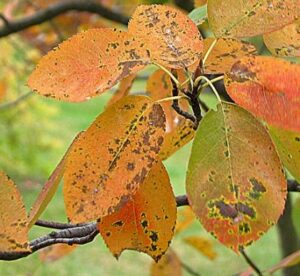
If you have a tree that concerns you either by its lack health and aesthetics or its structural integrity, you should have an evaluation done as early as possible.
In at least 75% of the cases we are called on, the tree can be restored to good health and made structurally safe, but time is of the essence. Trees showing signs of stress are often in a stage of continuous decline, and the sooner treatment is administered, the better the chances of recovery.
Of course if a tree is structurally at risk, the next heavy storm could bring it down. No one can predict when this will occur, but we can assess the level of risk.
We assess your trees from top to bottom. Look for these 5 major signs of a tree in decline or at risk of breaking or uprooting:
Dead branches or branch tips. This is usually the first visible sign that a tree is in declining health. This indicates diminished circulation either in a localized area or throughout the tree.
Wilted or discolored leaves. This is often caused by a lack of water, but can also be due to a fungal infection.
Fungus (also called “Conks”) growing out of the trunk, or mushrooms growing along roots. This indicates some internal decay inside the trunk, or roots that have died off. On a limited scale, this is usually not serious and can be treated over time.
Sawdust (also called “Frass”) in spots around the trunk base. This is serious. It indicates an insect borer, and usually when this is seen, the tree is beyond treatment.
Severe lean, trunk cavities, decay or cracks in the trunk or major limbs. These are structural defects, and the primary remedy is reduction pruning of the outer* canopy. By reducing the length of the limbs, we reduce both weight and wind stress – 2 major structural benefits.
Tree roots breathe Oxygen! This is a little known fact, but it is essential for their health. Most of the absorbing tree root tips live in the top 1-3 inches of soil where they can access oxygen in the pore space between soil particles.
Urban and suburban soils typically do not have the natural leaf & debris “mulch” that trees would have in a natural setting. This natural mulch creates a home for beetles, worms and grubs that “till” the soil and keep it oxygenated and nutrient rich. Without these elements, soils will become dry, barren and compacted over time.
This is a harsh environment for tree roots because the pore space for oxygen, and water absorption, is reduced. Roots can struggle or die, leading to dead limbs or whole sections in the tree canopy.
We use a proprietary method of Aeration & Deep Root Feeding in order to reintroduce this pore space and feed roots directly. This gives roots the oxygen and nutrients they need, and in addition enables the ground to absorb and hold water more effectively.
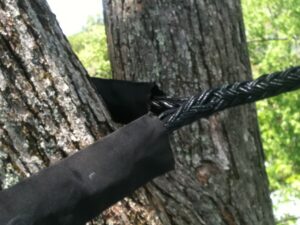
We use only non-invasive support cabling – this 1″ thick polypropylene based cable can support up to 4 tons and has a useful life of 15 years.
Support Cabling
If you have a tree with multiple trunks connecting at or near the base, you should have it evaluated for structural integrity. These trees are most at risk for structural damage.
In these areas where trunks or major limbs grow together at a narrow angle (or a tight “V”), the pressure they exert on each other increases each year as each trunk expands in size with its newest layer of wood (these are the rings you see in trees cut down).
In addition to the increase in pressure, the canopies up top continue to grow and add weight. With increasing mass, they also catch more of the wind and move around more in heavy storms. This all adds up to a high potential over the long term for a tree like this to split apart and collapse.
In conjunction with reduction pruning (to reduce canopy weight and mass), we can install support cabling between two or more trunks so that they help support each other and are less likely to split apart.
Old cabling systems use metal cables and hardware drilled into the tree. These can cause wood decay and as a result may weaken or fall out over time, as well as diminish the circulatory health of the tree.
The cabling we use is non-invasive and there are no metal parts. It is a dynamic, shock-absorbing polypropylene-based braided cable that is installed by wrapping around the trunk or limb, and it can support literally tons of weight. It is also flexible, expanding as the tree grows, so it can remain effective and in-place for many years.
Lightning Protection
Full disclosure – lightning protection systems can be expensive. They are primarily copper and are typically installed in very tall trees, requiring a lot of cable. They are, however, effective at re-directing the charge of a lightning strike and thus perhaps saving your tree.
Trees most at risk for a lightning strike are those that stand above most others in their surroundings. Strikes are surprisingly common – we see evidence of them in about 10% of the landscapes we visit. Their strength and intensity can vary from light (“just a flesh wound”) to heavy (total destruction) and anywhere in between. Just as in the case of people, a lightning strike may or may not destroy a tree.
If you have a beautiful, healthy “landmark” tree in your landscape, or one that forms the very foundation of your landscape, a lightning protection system may be a good investment.
GENERAL:
Every tree is an individual, with its own unique environmental, soil and underground conditions. Even a few feet can make a substantial difference in overall requirements. Some adjustment of these guidelines may be necessary for each tree.
If a tree is already established and healthy, it should be able to thrive mostly on its own. However, severe weather conditions can cause health stress for trees just as it does people. If a tree already has some challenges, whether natural or human-inflicted, sometimes supplemental watering during a critical weather event can mean the difference between life or death. Proper supplemental watering is also important when attempting to revitalize a stressed or dying tree.
All trees, regardless of age or size, should be given supplemental water during unusually hot and/or dry stretches of weather at any time of year, but MOST IMPORTANTLY during the hottest months of June, July and August.
GENERAL WATERING PATTERN:
Tree root zones should get a deep soaking (up to 18” depth ideally), then be allowed to dry out. DRYING OUT IS IMPORTANT. If the roots stay constantly wet, they will rot and the tree will die.
WHEN TO:
Late evenings or early mornings are the best time to water trees and plants.
October – March: Water only if there is an unusual period of drought (a week or more without rain), and no soaking rain is eminent.
April – September: Evaluate your watering needs when the temperature reaches 90 F or higher for 2 or more days in a row, with no recent soaking rain and none is eminent.
***June – August: These are critical months to monitor the weather. If weather conditions are stressful for humans, they are stressful for trees.
WHERE TO:
The goal is to soak the ground up to roughly 18” depth, in a “donut” shape around the tree, roughly underneath the outer 1/2 of the tree canopy. Watering any closer to the trunk is generally not as effective.
HOW TO:
1. Use a hose without a nozzle laid down anywhere in this “donut” zone. Allow it to run for 30 seconds, a minute, or more in each spot to achieve a good soaking, to approximately 18”. If you have no idea, just do the best you can, some water is better than none. However, note the necessity to let the ground dry out between waterings. Do not leave the hose to run in one spot for an extended time. Most of the time, 1-2 minutes is enough to achieve a good soaking given an average level of run-off.
2. Soaker hoses can also be used, placed around the tree in the donut zone (NOT near or against the trunk), and left on perhaps overnight for a thorough soaking, but don't forget to turn it off!
INDIVIDUAL CONSIDERATIONS:
Sun exposure. What is the tree's sun exposure? If the tree is situated mostly in the shade, less watering may be required. If in full sun, more may be required.
Drainage. Poor drainage can also affect the timing and amounts of supplemental water needed.
Slopes. Slopes can cause water to run off before soaking into the ground. This should be accounted for in watering.
MULCH:
If you use mulch, which can benefit trees only IF applied properly, we recommend using only coarse hardwood chips or pine bark (for evergreens) of roughly 1-2” diameter. No more than a single layer of 1-2” depth is necessary, more than this could be harmful as it does not mimic a tree's natural environment. We recommend NOT using shredded mulch, as this is often applied too deep, and can abruptly cut off the natural exchange of water and oxygen between the air and soil, which tree roots depend heavily on. In addition, shredded mulch over time will develop a glazed-over surface,
which causes most rain water to run off and not reach the tree roots. And in addition to that, shredded mulch will soak up much of the water that is meant for the tree roots. So if you use shredded mulch, apply it sparingly, less than 1" thick.
DO NOTS:
DO NOT OVERWATER. This is worse for your new tree than no supplemental watering at all. If the roots stay constantly wet, they will rot and the tree will die.
DO NOT USE A SPRINKLER TO WATER TREES. 2 problems with this. The water is spread too thin, and is likely not to soak deep enough into the ground to reach all of the absorbing roots. This method also sprays water onto the tree trunk, which is not natural (does not mimic the tree's natural environment), and can lead to trunk decay and circulatory problems.
DO NOT WATER THE TREE TRUNK. Water should be applied primarily underneath the outer half of the limbs for an established tree – this is where the majority of the absorbing roots will be.